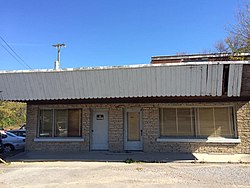Starday-King Sound Studios
| Starday-King Sound Studios | |
|---|---|
 Starday-King Sound Studios | |
| Location | 3557 Dickerson Pike Nashville, Tennessee 37207 |
| Built | 1960 |
Starday-King Sound Studios was a recording studio in the Madison neighborhood in northeast Nashville, Tennessee.[1][2]
History
[edit]Built in 1960, Starday Sound once was one of the city's busiest studios, with artists including James Brown, Dottie West and Jim Reeves recording there.[3]
When the studio opened as Starday Sound in May 1960, it was Nashville's third commercial recording studio, after RCA Studios and Bradley Film and Recording Studio.[4] Unlike those studios, it was not located in what was to become known as Music Row but in Madison, Tennessee, a bedroom community in northeast Davidson County.
The building shared space with Starday Records president Don Pierce's publishing company.[2] In 1963, Pierce ran a mail order distribution company, The Country Music Record Club of America, out of the building, with a warehouse built onto the existing building.[2]
Many of Starday Records' top acts, including Red Sovine and Cowboy Copas, recorded hits at Starday Sound, but the studio hosted more than country artists. For instance, Jimi Hendrix played guitar on a handful of R&B sessions there during the mid-1960s.[5] When Starday Sound's parent company acquired King Records after label founder Syd Nathan's death in 1968, the studio became known as Starday-King Sound.
James Brown recorded some of his biggest hits at the studio, beginning with "Get Up (I Feel Like Being a) Sex Machine", cut in the early hours of April 26, 1970, after Brown wrote the song backstage following a Nashville concert the previous night.[6] Brown also recorded "Super Bad", "Hot Pants", "I'm a Greedy Man" and several other songs there between 1970 and 1975.[3]
Preservation
[edit]In 2016, the mid-century modern building, which has sat vacant since 2000,[3][7] was named to Historic Nashville's Nashville Nine, a list of properties endangered by demolition, neglect or development.[8][9] There are petitions and an organized effort to save the studio.[2]
List of artists recorded
[edit]Following is a list of some notable artists who recorded songs at Starday-King Sound Studios.
See also
[edit]References
[edit]- ^ Ward, Getahn (9 October 2016). "2016 Nashville Nine: Music City's most endangered historic places". The Tennessean.
- ^ a b c d Fox, Randy; Galaz, Jason (28 October 2016). "Save The Starday-King Studios!". Muddy Roots Music.
- ^ a b c d e f g h i Robison, Julie (18 October 2016). "Starday-King Sound Studios". Historic Nashville.
- ^ "Recording Studio Boosts Nashville". The Nashville Tennessean. 29 May 1960. p. 14-C.
- ^ Roby, Steven; Schreiber, Brad (2010). Becoming Jimi Hendrix: From Southern Crossroads to Psychedelic London, the Untold Story of a Musical Genius. Da Capo Press. pp. 54–55. ISBN 978-0-306-81910-0. OCLC 548569631.
- ^ a b Hurst, Jack (27 April 1970). "James Brown May Join Nashville Superstar List". The Nashville Tennessean. pp. 1, 3.
- ^ "Abandoned Nashville studio where James Brown and Jimi Hendrix Once Ruled" (Video). Those Drones. 26 September 2016.
- ^ Robison, Julie (10 October 2016). "Historic Nashville Announces the 2016 Nashville Nine". Historic Nashville.
- ^ McMurry, David (9 October 2016). "Historic Nashville Announces 2016 Nashville Nine" (Press release). Historic Nashville.
- ^ "From the Music Capitals of the World". Billboard. 12 December 1970. p. 49.
- ^ Tribe, Ivan M. (1993). The Stonemans: An Appalachian Family and the Music That Shaped Their Lives. University of Illinois Press. p. 158. ISBN 978-0-252-01978-4. OCLC 26128439.
- ^ "Fiddlin' Smith Rites Tomorrow". The Nashville Tennessean. 2 March 1971. p. 26.
- ^ "From the Music Capitals of the World". Billboard. 6 June 1970. p. 64.
- ^ a b Gibson, Nathan D.; Pierce, Don (2011). The Starday Story: The House That Country Music Built. Jackson, Mississippi: University Press of Mississippi. ISBN 978-1-60473-830-8. OCLC 713030310.
